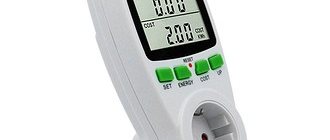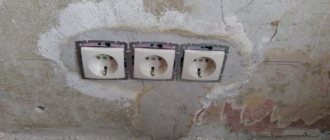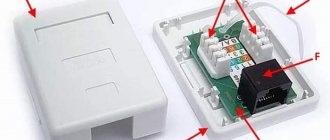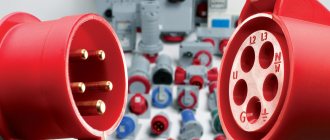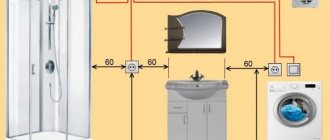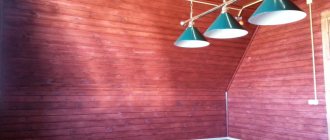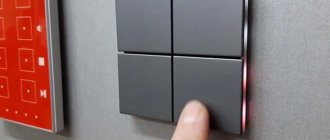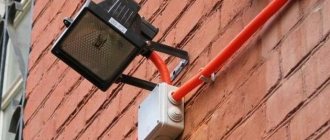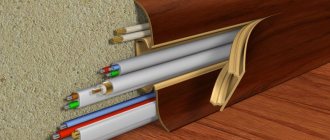Home » Electrical wiring » Sockets » Street sockets: features and installation rules
Every gardener or owner of a summer cottage has thought about placing an outlet on the street. Connecting a street outlet in the future will eliminate the need for inconvenient extension cords. Outdoor sockets are intended for use outside the home. They provide convenience when connecting outdoor equipment.
The outdoor socket is protected from moisture
In our article you will learn its features, installation rules and all the technical characteristics of street sockets.
Features of a street outlet
Outdoor sockets are manufactured according to all safety parameters and protection from external factors. Outdoor garden sockets are installed for further connection to lawn mowers, garden equipment and other devices. Installing them will make your task easier and you will no longer need to “carry” them.
Outdoor sockets are usually made of high quality steel. Additional elements are manufactured in accordance with European standards. These appliances must be installed on a solid base. For example, on concrete, hard ground or tiles. Often many consumers install them to control street lighting.
Socket on the outside wall of the building
This is necessary to ensure the ability to quickly turn on the lights and to adjust the light bulbs in the garden. Street sockets can be controlled:
- remote control;
- switch;
- special switch.
The choice of system will depend on the device model. If your area is large, then it is better to choose remote control. The street socket block allows you to control the following devices from one place:
- electric saws;
- lighting;
- mowers
Socket block CSB-104 for 4 sockets
In this design, the protection of the street outlet will be of high quality. A waterproof outdoor socket is another type of structure that is designed for installation outdoors. They provide security for the electrical network. These sockets are reliably protected from the adverse effects of natural conditions. High-quality devices will definitely withstand temperature changes, moisture and exposure to dust.
Outdoor sockets must be reliably protected from external factors. This is necessary to avoid outside interference in their work. The main factor of their safety is the presence of a metal case.
Comments:
Skept
As for me, it’s better to run the cable out of the house than to fence off an outlet on the property. Rain, snow, frost, dew are not the best friends for electricity
Andryukha
Skept, we are not talking about the fact that these sockets will be constantly connected to the network. They are usually connected to a separate package and work only in the dry season. Feed the gazebo or irrigation system according to schedule. You can, of course, pull the extension cord from your house to the gazebo every time you want to drink tea there, but it’s much more convenient to turn on the machine in the house and connect there.
Valentine
In the case of an outdoor outlet, I would not buy IP 66, because... it will still not be completely immersed in water, and there is no reason to pay twice as much for such functionality. If the socket is lying in a puddle, no matter how protected it is, I won’t not only plug it in, I won’t even touch it if it’s energized at the time
Jamis
For some reason, no one talks about protecting the person with the street socket. It seems that the text was written in 90. Firstly, it is imperative to install an RCD with a 5mA cut-off, like for a bathroom. And secondly, it is necessary to use an isolation transformer to eliminate the possibility of severe electric shock. If you do not use a 220V electric tool, then the best thing is to use safe voltages of 12 or 36V. Fortunately, there are plenty of such lamps in stores.
Leave a comment Cancel reply
Related Posts
A few simple rules for choosing sockets and switches
Installation instructions for sealed open type switch
German ABB sockets combine reliability and stylish design. How to choose a hidden wiring socket, practical advice.
Outdoor sockets with moisture protection
For the safety of many devices, sockets for outdoor installation have a high level of protection against moisture. According to international standards, it must have its own class of protection against dust or moisture. Those devices that are placed in boxes have a protection class of ip 44. At the moment, the street socket ip 65 is considered the most common. Outdoor sockets ip67 are also gradually gaining popularity. Here is the breakdown for the class and type of device:
- IP is international protection.
- The first digit in the class indicates the level of dust protection.
- The second number you can see indicates their level of protection.
Socket with protection class IP 65
Typically, outdoor devices are produced for outdoor use only. An overhead street socket is usually installed in the following places:
- in summer cottages or near the house;
- at car washes or parking lots;
- construction site;
- in parks.
You should also remember that appliances designed for indoor use are not suitable for outdoor installation. Internal ones have a low level of protection against moisture and therefore it is better to install them only in the house.
Where to put it and how to connect?
Before installing a socket for a protected design, you need to understand its functionality. For gazebos, the installation of the socket is carried out not on the wall, but inside the temporary structure. For the walls of houses and garages, external electrical products are installed below the canopy to protect them from moisture. To carry out housekeeping procedures on site, you need to purchase connectors sealed in a moisture-proof box.
Installation of the external electrical connector is carried out according to the proven scheme:
Features of connecting street outlets
An outdoor electrical outlet must have a durable casing. Here you can see what elements the socket consists of. Also, during installation, follow the instructions provided by the manufacturer. Basic installation rules include:
- Selecting a location.
- Cable connection method.
- Accounting for all necessary wiring parameters.
An all-weather outdoor socket will work correctly if all parameters are met. If you don't know how to install, contact a professional.
Choosing the Right Location
The best place to install these sockets is considered to be under the roof or canopy of the house. This must be taken into account to ensure that your device does not fall under a direct stream of water and is not damaged in heavy rain. All systems must be installed in special boxes or protected shields. You also need to remember that you need to choose the correct installation height.
Socket in a metal column
Almost all sockets that are installed outdoors have two cable outlets. If you want to avoid network problems, then it is better to install the cable through the lower opening. This is necessary so that the top of the cable does not become wet with water.
Cabling
When laying cables underground, you should keep in mind that such work is regulated by the PUE (Electrical Installation Rules). If installation is carried out directly into a trench, then the only option permitted by the PUE is a special armored cable for laying in the ground (for example, VbbShV, AVBbShv, PvBbShv). In swampy areas, on highly heaving and corrosive soils, it is strictly not recommended to lay cables directly into the ground. Laying other types of cables, for example VVG, is possible only in special corrugations or pipes, regardless of soil characteristics. Single-wall and double-wall products made of HDPE (low-density polyethylene) are considered optimal for cable protection. This material has good electrical insulating properties, high strength and durability, its service life is up to 50 years. Laying cables in steel pipes is strictly prohibited. When determining the cable route, you need to take into account the requirements of the PUE for safe distances to various objects. Thus, you cannot lay cables closer than 1 m from communications: water supply, sewerage, drainage system, gas pipeline. It is undesirable to cross with other cables and pass under areas with heavy ground load or frequent excavation work. The distance to large trees should be at least 2 m, shrubs - 0.75 m, buildings - at least 0.5 m. The minimum cable laying depth according to the PUE is 0.7 m; on cultivated lands and for high-power cables it is advisable to increase it up to 0.9–1 m. It should be taken into account that the depth of the trench should be greater, since a sand cushion 10 cm thick is placed at its bottom. The cable must be solid, without joints, along the entire length of the installation; the corrugation or pipe must also be solid or with a minimum number of sealed connections. When laying the cable, you must ensure that it lies freely, without tension. After finishing the work, it is covered with a 10 cm layer of sand and soil. A warning tape is laid across the soil surface.
Accounting for wiring parameters in the house
Each wiring may have its own nuances that allow moisture to seep inside. Moisture that gets into the outlet usually causes frequent short circuits. A socket with a cover is perfect for outdoor use, as it will increase the degree of protection from moisture. If you decide to install an outlet on the street, then remember that the cable that is supplied to it must be completely solid. There should be no connections on it through which moisture can leak.
InScenio system from OASE
It is important to know! When installing this device, it must be placed on a surface that is not subject to fire.
Varieties
A protected waterproof socket is:
According to the installation method, sealed sockets protected from moisture are:
Built-in types of electrical sockets, protected from moisture, have special hidden devices. For closed connectors, an additional hidden socket box is required. Built-in protected double sockets are more aesthetically pleasing than special overhead types of sockets with a switch.
Protected surface mounted electrical outlets have fewer installation requirements. They are installed on the wall, so the surface-mounted socket box will be protected from moisture outdoors. A special hinged lid of the box protects the connectors from rain. To comply with safety standards, single and double surface-mounted sockets are more reliable for outdoor installation than built-in type electrical connectors protected from moisture.
Design parameters
Lengrand street sockets have several parameters that make them possible to use outdoors:
- Availability of protective membrane and grounding.
- All contacts are bronze plated.
- The design includes special gutters that will help remove moisture inside.
- The body is made of thermoplastic.
Legrand Plexo
In some stores you can see devices that have a rubber body. Outdoor extension cords are usually made from rubber.
Country electrics in the open air
Electrical equipment operating outdoors is often used at a summer cottage. Pulling an extension cord is inconvenient and unsafe, especially if the area is large. It is much more practical to be able to connect the device to an outdoor outlet.
Light garden buildings - gazebos and open verandas - often need electricity. How to choose country electrics and install them correctly?
Rules for installing a street outlet
Outdoor sockets are great for outdoor installation. Many people use it for New Year's holidays. New Year's garlands and other luminous elements are connected to it. Connecting the outlet yourself should only be done by professionals. This is due to the fact that here you need to follow all safety rules and take into account the influence of external factors.
Special post for two sockets
To install, you may need to select a location first. Next, you should consider the height in order to avoid further problems.

